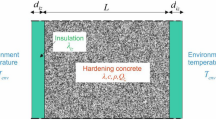Abstract
Drying shrinkage of concrete may still be the main source of cracking in concrete structures, even though the autogenous shrinkage of concrete can be effectively reduced by using internal curing. In the present paper, the effect of internal curing with pre-soaked lightweight aggregate and engineered cementitious composite permanent formwork (ECC-PF) on a moisture distribution in three kinds of concrete in a drying environment are investigated from both aspects of experiments and theoretical modeling. The test results show that the combination use of ECC-PF and internal curing can well maintain the humidity at a relatively high level not only at a place far from drying surface, but also at a place close to the drying surfaces. The developed model can well catch the characteristics of the moisture distribution in concrete under drying and the impacts of internal curing and ECC-PF can well be reflected as well. The model can be used for the design of concrete structures with combination use of internal curing and permanent formwork.
























Similar content being viewed by others
References
Ayano, T., Wittmann, F.H.: Drying, moisture distribution, and shrinkage of cement-based materials. Mater. Struct. 35(247), 134–140 (2002)
Baroghel-Bouny, V., Mainguy, M., Lassabatere, T., Coussy, O.: Characterization and identification of equilibrium and transfer moisture properties for ordinary and high-performance cementitious materials. Cem. Concr. Res. 29(8), 1225–1238 (1999)
Bazant, Z.P., Najjar, L.J.: Nonlinear water diffusion in nonsaturated concrete. Mater. Struct. 5(25), 3–20 (1972)
Bentur, A., Igarashi, S., Kovler, K.: Prevention of autogenous shrinkage in high-strength concrete by internal curing using wet lightweight aggregates. Cem. Concr. Res. 31(11), 1587–1591 (2001)
Bissonnette, B., Pierre, P., Pigeon, M.: Influence of key parameters on drying shrinkage of cementitious materials. Cem. Concr. Res. 29(10), 1655–1662 (1999)
Brunauer, S., Skalny, J.: Adsorption on nonporous solids. J. Colloid Interface Sci. 30, 546–552 (1969)
Chanvillard, G., Daloia, L.: Concrete strength estimation at early age: modification of the method of equivalent age. ACI Mater. J. 94(6), 220–227 (1997)
Han, Y.: Shrinkage control of modern concrete. Ph.D. thesis, p. 211, Tsinghua University, Beijing, China (2014) (in Chinese)
Henkensiefken, R., Bentz, D., Nantung, T., Weiss, J.: Volume change and cracking in internally cured mixtures made with saturated lightweight aggregate under sealed and unsealed conditions. Cem. Concr. Compos. 31(7), 427–437 (2009)
Jensen, O.M.: Autogenous deformation and RH-change–self-desiccation and self-desiccation shrinkage. Building Materials Laboratory, The Technical University of Denmark, Lyngby, Denmark, 1993, R 285/93
Kim, J.K.: Estimation of compressive strength by a new apparent activation energy function. Cem. Concr. Res. 31(2), 217–225 (2001)
Kjellsen, K., Detwiler, R.J.: Later-age strength prediction by a modified maturity model. ACI Mater. J. 90, 220–227 (1993)
Li, V.C.: Advances in ECC research [D]. In: ACI Special Publication on Concrete: Material Science to Applications, SP 206-23, pp. 373–400 (2002)
Luzio, G.D., Cusatis, G.: Hygro-thermo-chemical modeling of high performance concrete. I: Theory. Cem. Concr. Compos. 31, 301–308 (2009)
Nilsson, L.O.: Long-term moisture transport in high performance concrete. Mater. Struct. 35, 641–649 (2002)
Oh, B.H., Cha, S.W.: Nonlinear analysis of temperature and moisture distribution in early-age concrete structures based on degree of hydration. ACI Mater. J. 100(5), 361–370 (2003)
Pane, I., Hansen, W.: Concrete hydration and mechanical properties under nonisothermal conditions. ACI Mater. J. 99(6), 534–542 (2002)
Parrott, L.J.: Influence of cement type and curing on the drying and air permeability of cover concrete. Mag. Concr. Res. 47(171), 103–111 (1995)
Powers, T.C., Brownyard, T.L.: Studies of physical properties of hardened Portland cement paste. J. Am. Concr. Inst. 18, 101–132, 249–336, 469–504, 549–602, 669–712, 845–880, 933–992 (1946–1947)
Rastrup, E.: Heat of hydration. Mag. Concr. Res. 6(17), 127–140 (1954)
Schindler, A.K., Folliard, K.J.: Heat of hydration models for cementitious materials. ACI Mater. J. 102(1), 24–33 (2005)
Xi, Y., Bažant, Z.P., Jennings, H.M.: Moisture diffusion in cementitious materials—adsorption isotherms. Adv. Cem. Based Mater. 1(6), 248–257 (1994)
Zhang, J., Gong, C., Guo, Z., et al.: Engineered cementitious composite with characteristic of low drying shrinkage. Cem. Concr. Res. 39(4), 303–312 (2009a)
Zhang, J., Qi, K., Huang, Y.: Calculation of moisture distribution in early-age concrete. J. Eng. Mech. 135(8), 871–880 (2009b)
Zhang, J., Hou, D., Sun, W.: Experimental study on the relationship between shrinkage and interior humidity of concrete at early age. Mag. Concr. Res. 62(3), 191–199 (2010)
Zhang, J., Hou, D., Gao, Y., Sun, W.: Determination of moisture diffusion coefficient of concrete at early-age from interior humidity measurements. Dry. Technol. 29(6), 689–696 (2011)
Zhang, J., Hou, D., Han, Y.: Micromechanical modeling on autogenous and drying shrinkages of concrete. Constr. Build. Mater. 29(3), 230–240 (2012)
Zhang, J., Han, Y., Luosun, Y.: Combination effects of internal curing and permanent formwork on shrinkage of high strength concrete. J. Adv. Concr. Technol. 12(11), 456–467 (2014)
Zhang, J., Wang, J., Han, Y.: Simulation of moisture field of concrete with pre-soaked lightweight aggregate addition. Constr. Build. Mater. 96, 599–614 (2015)
Zhang, J., Han, Y., Zhang, J., Gao, Y.: Evaluation of shrinkage induced cracking in concrete with impact of internal curing and water to cement ratio. J. Adv. Concr. Technol. 14(7), 324–334 (2016a)
Zhang, J., Wang, J., Gao, Y.: Moisture movement in early-age concrete under cement hydration and environmental drying. Mag. Concr. Res. 68(8), 391–408 (2016b)
Zhang, J., Wang, J., Ding, X.: Test and simulation on moisture flow in early-age concrete under drying. Dry. Technol. (2017). doi:10.1080/07373937.2017.1315588
Acknowledgements
This work has received the support of a grant from the National Science Foundation of China (51678342) and a grant from a Specialized Research Fund for the Doctoral Program of Higher Education (20130002110034) to Tsinghua University.
Author information
Authors and Affiliations
Corresponding author
Rights and permissions
About this article
Cite this article
Wang, J., Zhang, J., Ding, X. et al. Effect of cementitious permanent formwork on moisture field of internal-cured concrete under drying. Mech Time-Depend Mater 22, 95–127 (2018). https://doi.org/10.1007/s11043-017-9354-z
Received:
Accepted:
Published:
Issue Date:
DOI: https://doi.org/10.1007/s11043-017-9354-z




